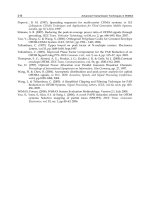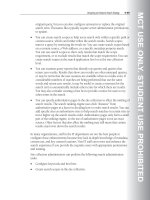Ebook Advanced myofascial techniques (Vol.1): Part 2
Bạn đang xem bản rút gọn của tài liệu. Xem và tải ngay bản đầy đủ của tài liệu tại đây (21.92 MB, 218 trang )
PelvicGirdle
10HipMobility
11SciaticPain
12TheSacrotuberousLigament
13TheSacroiliacJoints
14TheIlia
HipMobility
10
Figure10.1
Theiliofemoral,pubofemoral,andischiofemoralligamentslimithipmotion.
WhenIwasastudentattheRolfInstituteinthe1980s,Iheardastoryaboutits
founder,Dr.IdaRolf,whichunderlinedtheimportanceofpelvicmobilityinher
work. According to the story, Dr. Rolf would regularly quiz her trainees about
theaimsofeachofherten“hours”orsessions.
Shereportedlyaskedherclassesquestionssuchas,“Whatisthegoalofthefifth
hour?” As a demanding teacher, very few answers would satisfy her; but even
thougheachsessionwasdifferent,shereportedlyacceptedtheanswer“freethe
pelvis”asacorrectone,nomatterwhichsessionshewouldaskabout.
While this story probably has an element of folklore to it (since her death in
1979, many “Ida stories” have assumed the status of legend in the structural
integrationcommunity),itillustratesthekeyrolethatpelvicadaptabilityatthe
hipjointsplayedinhervisionofanintegratedbody.Dr.Rolfreferredtothehips
and pelvis as “the joint that determines symmetry.” She was not alone in
emphasizingthekeyroleofthehips;balancedhipjointmobilityisimportantin
fieldsasdiverseasathletics,dance,geriatrics,andbackpainmanagement.
Ibecameevenmorecuriousabouttherelationshipofthelowbacktohip-joint
mobility when I traveled to Japan to teach and practice manual therapy, a few
yearsaftergraduatingfromtheRolfInstitute.Inoticedchallengesinmyownhip
mobilityasIadjustedtotheJapanesepracticeofsittingonfloorcushionsmore
often than on chairs. I noticed considerably more hip mobility (especially
externalrotation)inmyJapaneseclientelethanIhadseeninmyAmericanand
Europeanclients.
MyJapaneseclientsalsoseemedtohavegenerallyflatterspinalcurves.Wasthis
alsorelatedtotheirhipmobility?Inutero,humansdevelopwithflexedhipsand
no secondary lumbar curve (Figure10.2 ). It is only once they begin to crawl
(Figure 10.3 ) and extend their hips that they develop a lumbar curve.
Conventionalwisdommaintainsthatfreerhipsmeanhappierbacks,andresearch
bothinJapan(1)andintheUSA(2)generallysupportsthis.
WatchTilLuchaudemonstratethePushBroomtechniques: />
Figures10.2/10.3
Infantshavemorehipflexionasaresultoftheirpositioninutero.
In this chapter, I will describe three techniques that are used to assess and
balancehipjointmobility,whichcanbeusefulwhenworkingnotonlywithhip
mobility issues directly, but as a way to ameliorate low back pain and other
issues.
Techniques
PushBroom“A”Technique
The “Push Broom” series is an effective way to increase hip joint mobility
withoutundueeffortorstrainbythepractitioner.Usinggravity,wewilltakethe
hip through three positional techniques that will release all of the structures in
thehipjoint:fromthedeepiliofemoralligaments(Figure10.1),totheiliopsoas,
hamstrings,hipabductorsandadductors,rotators,sartorius,quadriceps,andtheir
envelopingfascias.
Theterm“pushbroom”referstothestartinggrip:holdyourproneclient’slegat
the ankle and knee as if holding the handle of a push broom (Figure 10.4 ).
Swingthekneeoutwardsasyouwalkthelegupintofullhipflexion,bringing
the knee as far towards the head as comfortably possible. Rolling the pelvis
awayfromyouasyoubringthekneeupwillmakeiteasiertoflexthehippast
the90-degreepoint.Withalmostallclients,itwillbemorecomfortableifyou
takethelegpastthis90-degreepositionsothatthefemurisclosetothesideof
thebody,ratherthanperpendiculartoit.
Simplybeingputintothis“babycrawling”or“bullfrog”positionoftengivesa
therapeuticstretchtothehipjoints;however,whilewearehere,wecanincrease
hip mobility by releasing the gluteals. While stabilizing your client’s leg with
yourown,usetheflatofyourforearmtogentlyleanintothemedialattachments
of the gluteus maximus just below the iliac crest (Figures 10.5 and 10.6 ).
Tendinous attachments have concentrations of Golgi tendon organs. These
respond to sustained pressure, so you will get the best results by waiting with
slow,nearlystaticpressurehere,ratherthanslidingormovingyourtouch.Use
moderatepressure,withaslightvectorofpressuretowardsyourself,inorderto
easeornudgethegluteusawayfromitsbonyattachmentsontheilium.
Figure10.4
The“A”variationofthePushBroomTechnique.
Figure10.5
Oncethehipisflexedwiththelowerlegonthetable,useyourforearmstoreleasethemedial
attachmentsoftheglutealmuscles.
Gently sustain this pressure until you feel the tissue respond with a subtle
softeningoreasing;then,releaseyourpressureandmovetothenextsegmentof
glutealattachments.
Keypoints:PushBroomTechniques
Indicationsinclude:•Limitedhipmobility.
•Balanceorgaitissues.
•Back,sacroiliac,orsciaticpain.
Purpose
•Restoremobilityandrefineproprioceptionattheiliofemoral(hip)joint.
Instructions
•Withoutcausinganypain,gentlybringlegintoflexed,abductedandrotated
positionsasdescribedinthetext.Usestaticpressureonmuscleattachments.
•Waitineachpositionforatissueresponsetothestretch.
•Repeatwithotherhip.
For almost all clients, the position is more comfortable when taken past 90
degreesofflexion.
Cautions
• Certain movements may be contraindicated for recent hip replacement
patients.
Figure10.6
Themedialattachmentsofthegluteusmuscles.
Figure10.7
The“B”(externalrotation)variationofthePushBroomTechnique.
PushBroom“B”(ExternalRotation)
While still in the leg-up position of the Push Broom “A” technique, drop your
client’s lower leg off the table (Figure 10.7 ). Roll the femur into external
rotationbyliftingtheadductorstowardsyouwithbothhands.Thisalsoallows
youtopreventanypressurethattheedgeofthetablemightotherwiseputbehind
yourclient’sknee.Atthesametime,useyourlegunderthetabletoaugmentthe
femoral rotation by gently pressing your client’s foot towards the head of the
table. Your client should feel no strain on the knee or anywhere else – only a
stretchandreleasearoundthehipjoint(Figure10.8).Omitthepressureonyour
client’sfootifitproducesanydiscomfort.
Stay comfortable and upright in your own body. Invite your client to breathe
easilyandrelaxintothestretch.Sustainthispositionaltechniqueuntilyoufeela
response–softening,easing,orrelaxing.Usuallythistakesatleastthreetofive
breaths.
PushBroom“C”(InternalRotation)
Specific kinds of hip mobility have been correlated with low back health.
Internalhiprotation,hipflexion,andhipextensioninbothsexes,andhamstring
flexibilityinmen,allhaveanegativecorrelationwithbackpain(thatis,people
with those types of mobility generally have less back pain) (3). The “C”
variation of the Push Broom Technique combines several of these important
motions:internalfemoralrotation,hipflexion,andhamstringstretch.
Fromtheexternalrotation“B”variation,gorightintointernalrotationwithPush
Broom“C”.Insteadofdroppingthelowerlegbelowthelevelofthetableasin
“B”,rotatethefemursothatthelowerlegishigh.Byusingthegripandposition
shown in Figure 10.9 , gently take the femur to its soft end-range of internal
rotation;hold,andwaitfortissueresponse.Remembertokeepthehipflexedat
least 90 degrees (that is, keep the femur perpendicular to the body, or even a
littlepastthispositiontowardthehead).Asinthe“B”variation,bemindfulto
avoidstrainordiscomfortontheknee.
Figure10.8
Viewingthehipjointfrombelowhelpsvisualizehowexternalrotationcanopentheanteriorhipjoint.
Figure10.9
The“C”variationofthePushBroomTechnique(internalrotation).
OnceyouhavecompletedthesethreePushBroomvariationsononeleg,return
thelegtoitsanatomicalposition.Clientswilloftencommentthatthislegfeels
significantlylongerandfreerthantheoneyouhavenotyetworkedon.Repeat
thesetechniqueswiththeothersidetobalancetheleftandrightsides.
OtherconsiderationsAlthoughwehavedescribed
thesethreevariationsaboveashipjointtechniques,
theyalsoaffecttheligamentousadaptabilityofthe
pelvicgirdleitself,mobilizingthesacroiliacjointsby
addressingsacrotuberous,sacrospinous,and
sacroiliacligamentrestrictions,andbalancingthe
torsionandflaringmovementsoftheiliaonthe
sacrum.Thismakesthemusefulinaddressing
appendicularsciaticpain(Chapter11),sacrotuberous
pain(Chapter12),sacroiliacpain(Chapter13),and
otherconditionsofthepelvis.Ifyourclientorpatient
isunclothedorminimallyclothed,youcandrape
thesetechniquesbysimplygraspingthelegthrough
thetopsheetinvariation“A”,andmovethesheet
togetherwiththeleg.Alternatively,especiallyforthe
“B”and“C”variations,thelegcanbeoutofthe
drape,withthesheetgatheredaroundthethighsoas
togiveasenseofsecurityandprivacytotheclient.
Whenapplyingthetechniquesdescribedhere,itis
importantthattheydonotcausepain.Inadditionto
soft-tissuerestrictionstomobility,therecanbebony
restrictionsaswell,suchastheshapeororientationof
theacetabulaorfemoralheads.Thesecancausepain
orirritationwhenpushedtotheirphysiologiclimit.
Femoralacetabularimpingement(FAI)syndromeisa
painfulrestrictionofhipmovementcausedby
abnormalcontactbetweenthefemurandtherimof
theacetabulum,probablyduetobothgeneticand
usagefactors.Althoughoftenaddressedsurgically,
techniquesthatincreasemobilityarealsoeffectivein
managingFAIpain–thoughpushingastretchtoo
aggressivelycanaggravatethiscondition,souse
cautionattheendrangesofmotion,especiallyifthere
isdiscomfortdeepinthehipjointitself.
Figure10.10
X-rayofatotalhipreplacement(totalhiparthroplasty)
Whatabouthipreplacements?
Althoughthepreventionofdifficultiesismoredifficulttomeasureorstudythan
thedifficultiesthemselves,itisreasonabletoassumethatmaintainingbalanced
hip mobility can help prevent or ameliorate the joint pain, degeneration, or
arthriticconditionsthatifotherwiseunaddressed,canleadtohipreplacementor
resurfacing.
If your client has already had hip replacement surgery (Figure10.10 ), special
considerationsmayapplywhenusingthesetechniques.Hipreplacementsurgery
involvescuttingthroughtissues anddislocatingthejointbeingreplaced,either
posteriorlyoranteriorly,dependingonthetypeofsurgery.Thiscanleavethehip
with less support in the direction of the surgical dislocation, at least during
recovery.1
Differenttypesofhipsurgerieshavedifferentmovementrestrictionsassociated
with their recovery period. Surgeons also differ widely in their recommended
movement restrictions after surgery. In 2010, during an informal survey of hip
surgeons’ recommendations to yoga teachers, it was found that a third of
respondingsurgeonsdidnotrequireanymovementrestrictionswhatsoeverafter
an anterior hip replacement (4). However, the most conservative
recommendations say that for six months to one year after surgery, hip
replacementpatientsshouldavoid:•Adduction,internalrotation,andhipflexion
past 90 degrees for posterior hip replacements • Abduction, external rotation,
andhipextensionforanteriorreplacements.
Giventhesevariables,thebestpracticeformanualtherapistsistoinquireabout
anymovementsthattheclient’ssurgeonorrehabilitationtherapistrecommended
avoidingduringtherecoveryperiod.
Many hip replacement patients continue to experience soft tissue-based
movement restrictions long after their surgeries have fully healed. For these
older,healedhipreplacements(approximatelyoneyearormoreaftersurgery),
thesetechniquescanbeagreathelpwithlonger-termrecoveryandmaintenance
ofmobility.However,giventhatwearenottryingtostretchoraltertheartificial
materials of the prosthesis itself, go easy on the end-range of any stretching
applied to the replaced hip. Think about keeping the tissues around the joint
long, easy, and mobile, rather than trying to deeply stretch the artificial joint
itself.
Finally, do not hesitate to adapt these techniques for senior or physically
challengedclients.Bybeingsensitiveandstayingincommunicationabouttheir
comfort,youwilloftenbesurprisedastohowcomfortableandeffectivethese
releasesare,evenforthosewithlimitedactivemobility.
With practice, these techniques will become indispensable parts of your
technique toolbox, enabling you to assess and release many hip restrictions
within the context of your regular work. Your clients of all ages and activity
levels will appreciate this: whether we have lower back pain or not (and 80
percentofpeopleexperiencebackpainatsomepointintheirlives),mostofus
willbenefitfromincreasedhipadaptability,asitmakesoursitting,walking,and
movingeasier,moreefficient,andmorecomfortable.
References
[1]Horikawa,K.etal.(2006)Prevalenceofosteoarthritis,osteoporoticvertebralfractures,and
spondylolisthesisamongtheelderlyinaJapanesevillage.JournalofOrthopaedicSurgery.14(1).p.9–12.
[2]Harris-Hayes,M.etal.(2009)Relationshipbetweenthehipandlowbackpaininathleteswho
participateinrotation-relatedsports.JournalofSportRehabilitation.Feb;18(1)p.60–75.
[3]Mellin,G.(1988)Correlationsofhipmobilitywithdegreeofbackpainandlumbarspinalmobilityin
chroniclow-backpainpatients.Spine.13(6)p.668–670.
[4]Jones,N.M.(2010)YogaafteraHipReplacement..[Accessed5/2014]
Picturecredits
Figures10.1,10.6and10.8courtesyPrimalPictures,usedbypermission.
Figure10.2isapublicdomainimage.
Figures10.3,10.4,10.5,10.7and10.9courtesyAdvanced-Trainings.com,usedbypermission.
Figures10.10isapublicdomainimagefromtheNationalInstitutesofHealth.
StudyGuide
HipMobility
1Thetextcitesresearchthatindicatesthatfreerhipscorrelatewith:
alesskneepain
blessbackpain
clessshoulderpain
dlessjawpain
2Whichtypesofhipmobilityhavebeencorrelatedwithlowbackhealthin
bothmenandwomen?
aexternalhiprotation,hipflexionandextension
binternalhiprotation,hipflexionandextension
cinternalhiprotation,hipflexionandhipabduction
dexternalhiprotation,hipflexionandhipadduction
3InthePushBroom“A”Technique,thepractitionerappliesstaticpressure
totheattachmentsofthegluteusmaximus:
ajustabovetheiliaccrest
bjustbelowtheiliaccrest
cattheischialtuberosity
dthegluteusmaximusattachmenttotheITT
4 The author statesthatthe Golgitendonorganslocatedinthetendinous
attachmentsrespondbestto:
aslidingpressure
bpulsingpressure
clightpressure
dsustainedpressure
5ThetextsuggestsholdingthepositionofthePushBroom“B”Technique:
a3–5minutes
b3–5breaths
c3–5seconds
d3–5times
ForAnswerKeys,visitwww.Advanced-Trainings.com/v1key/
1 To learn more about the procedures involved in a posterior replacement, I recommend checking out
edhead.org’sinteractivehipsurgerysimulatoratwww.edheads.org/activities/hip/.Thesqueamishneednot
beconcerned–theanimatedprocedureskeepitneatandtidy,unlikerealposteriorhipsurgeries,which
canappeardownrightgoryandbrutaltotheuninitiated.Accessed5/2014.
SciaticPain
11
Figure11.1
Theoriginsofthesciaticnerve–thelargestandlongestnerveinthebody.Painresultswhenitsnerve
rootsarecompressedwheretheyexitthelumbarspine(axialsciatica)orwhenitisentrappeddistallyby
otherstructures(appendicularsciatica).Thedura(aquacolor),psoas(green),andpiriformis(red)are
someofthestructuresthatcancontributetosciaticpain.
Sciaticaisarealpainintherear–notjustfortheindividualswhoexperienceit,
butcollectively,forsocietyasawhole.Althoughestimatesvary,studiesindicate
thatupto43percentofpeopleexperiencesciaticpainatsomepointintheirlives
(1).A2008meta-analysisofsciaticstudiesconcludedthatsciaticpainismore
persistent,moresevere,andconsumesevenmorehealthresourcesthanlowback
paindoes(2).
Sciaticacanalsobeapainformanualtherapypractitioners.Sometimes,sciatic
pain responds quickly; at other times, it seems intractable, and it can even
worseninresponsetohands-onwork.Asapractitioner,howdoyoudetermine
whichapproachesaremostlikelytobehelpful?Inthischapter,wewilltakea
look at straightforward and relatively reliable assessments for differentiating
betweenthetwotypesofsciaticpain;wewilldiscussimportantconsiderations
forworkingwiththefirst(axial)type;andwewilldescribethetechniquesand
approachesusedforrelievingthesecond(appendicular)type.
Much of sciatica’s ubiquity and variability comes from the broadness of the
term. Originally derived from “ischialgia,” meaning pelvic or ischium pain,
sciatica has come to mean any pain involving the lower back or buttocks that
radiatesdowntheposteriorleg.Sciaticaisasymptom,notadiagnosis;thereare
many possiblecausesofsciaticpain,and knowinghow to distinguish between
its different types will allow you to be far more effective in your work (and it
willhelpyoutoknowwhentorefertoaspecialist).
One thing is common to all sciatic pain: it is nerve pain, and so it can be
radiating, shooting, sharp, tingling, or numb. Sciatic pain involves an irritating
mechanicalforceonanerve,usuallysomewherealongtheneurons(nervecells)
thatmakeupthesciaticnerve(usuallybecauseirritationoftheothernervescan
sometimesradiatetothesciaticnervedistributionareaaswell).
AxialSciatica
AppendicularSciatica
Alsoknownas...
TypeI,“TRUE
SCIATICA”
TypeII,
“PSEUDOSCIATICA”,
PiriformisSyndrome,etc.
Entrapmentsite
Nerveroots
Distaltonerveroots
Entrapment
mechanism
Bone-to-boneor
disc-to-bone
compression
Myofascialcompressionor
neurofascialtethering
Lowbackpain
Usuallypresent
Usuallyabsent
Posteriorthigh
and/orbuttock
pain
Usuallypresent
Usuallypresent
Paindistalto
knee
Usuallyabsent
Sometimespresent
Table11.1Typesofsciaticpain.Inadditiontothemechanismsofentrapmentlistedabove,infection,
tumors,anddirecttrauma(eitheratthenerverootsordistally)canalsocausenerveentrapmentandsciatic
symptoms.
Assessingsciaticpain
Sciaticpaincanbedescribedasoneoftwotypes,asoutlinedinTable11.1:
I.Axialsciaticaarisesfromcompressiononthenerverootsattheintervertebral
foraminaofnervesL1–S31(3).
II.Appendicularsciaticaispainfromnerveentrapmentdistaltothenerveroots.
The firsttype,axialsciatica, involvesnarrowingoftheforamina(theopenings
betweenthevertebrawheretheperipheralnervesexitthespinalcanal(Figures
11.1,11.2and11.9).Thisnarrowingcanresultfrom:
• Postural or positional issues – for example, the postural strain of later-term
pregnancy, sacral instability, or spondylolisthesis (the instability and anterior
shiftofavertebraontheonebelowit,narrowingtheirintervertebralforamen)
•Articulardiscdegeneration,herniation,orbulgingintotheforaminalspace
•Stenosis(bonydepositsintheforamenorspinalcanal).
Thesemechanismsinvolvecompressionofthenerverootsbetweentheadjacent
vertebrae (bone-to-bone compression) or between a disc and vertebra (disc-tobone).Therearealsoreportsofsmallaccessorymusclesbeingfoundwithinthe
foramenparalleltothenerves(4),aswellasduraltubeadhesionsatthenerve
roots – either of which could conceivably cause axial sciatic pain. Infections,
tumors,cancer,ortraumaatthenerveroots(orelsewherealongthenerve)can
also cause sciatic pain, and they are the reasons why referral to a specialist is
prudentwhensciaticpainispersistent,unresponsive,orsevere.
Figure11.2
Protrudingordegeneratedintervertebraldiscs(green)orthedura(aquacolor)canimpingethenerve
rootswheretheyexitthespinalcanal,resultinginaxialsciaticpain.
Axialsciaticawillshowoneormoreofthesesigns:
• Pain in the low back along with buttock or thigh pain, usually without pain
belowtheknee(unlesstherearealsoappendicularcontributors)2
•“Sciaticscoliosis”:areluctancetoputweightontheaffectedside,resultingin
leaningawayfromtheaffectedsideinordertominimizepain.
•Apositive(i.e.,painful)resultwhenperformingtheStraightLegTest.
StraightLegTest
The Straight Leg Test (SLT) or the Lasègue Test is a common and reasonably
reliable assessment for identifying lumbar nerve root compression. With your
clientseatedatthefrontedgeofachair,askhimorhertoraiseastraightenedleg
atthehip(thatis,withhisorherkneeextendedstraight).Thestraightlegtestis
positive(meaningthatitindicateslikelynerverootcompression)ifsciaticpain
isreproducedwiththemotionslistedinthecaptionofFigure11.3.Paininthe
opposite(supporting)legcanbeduetomoreseveredischerniation,andisclear
causeforreferral.
Whydoankledorsiflexion,slumping,orneckflexionincreasesciaticpaininthe
SLTwhenanerverootiscompressed?Allthreeofthesemovementsstretchthe
nervetissuesfurther,puttingalittlemoretensiononanyentrapment.Slumping
andneckflexionalsopullupwards(caudally)ontheduraltubewithinthespinal
canal. The dural tube’s projections surround the nerve roots and line each
foramen(Figure11.2),sorestrictionsherecanbeacauseofaxialsciaticpain.If
this is the case, the slump test itself can be a helpful self-treatment, gently
stretching the dural adhesions. Clients should be instructed not to over-do the
stretching, or do too many repetitions, so as to avoid aggravating the already
inflamednerveroots.
Figure11.3
TheStraightLegTest(SLT)indicatesprobablenerverootcompressionif:1)sciaticpainisreproduced
between30°and70°ofhipflexion(70°ispictured);2)painworsenswithankledorsiflexion,slumping,
orneckflexion(droppingtheheadforward);or3)painisrelievedbykneeflexionoftheraisedleg.
TheSLTcanalsobeperformedpassively,orwithyourclientsupineinsteadof
sitting. Including these variations may increase the accuracy of your findings.
Supinetestingdoesnotallowfortheslumptest,butitdoesmakeiteasiertoadd
the bowstring variation of the SLT (described later in this chapter), which can
help determine if there is appendicular involvement in addition to axial sciatic
nerveentrapment.
When performed and interpreted correctly, the SLT has a high statistical
sensitivity (91 percent of correct positive results), but a lower statistical
specificity(26percentofcorrectnegativeresults)(6).Inotherwords,theSLTis
quitereliableatindicatingcompressionofthesciaticnerveroots(aboutnineout
oftenpositiveresultswillaccuratelyindicatenerverootinvolvement).However,
theSLTislessreliableatdeterminingwhenthereisnotnerverootcompression
(inotherwords,amongthosewhohavenerverootcompression–asverifiedby
otherclinicalmeans–threeoutoffourwilltestnegativewiththeSLT).Inother
words,theSLTisfairlygoodatrulinginnerverootcompression,butitisfairly
badatrulingitout.
Of course, you should keep in mind that unless your training and licensing
specificallypermityoutodiagnoseconditionslikediscissues,itisinappropriate
toofferyourclientadiagnosis,orevensuggestaninterpretationoftheSLT,for
a variety of good reasons. Even if you are a physician or other licensed
professional whose scope of practice does include diagnosis, telling someone
withapositiveSLTthattheyhaveanineintenchanceofhavinganerveroot
entrapmentisaloadedandpotentiallycomplexconversation,withthepotential
forinadvertentharmaswellasgood.Formostmanualtherapists,apositiveSLT
is reason to refer the client to a specialist for further evaluation, or to confirm
thatyourclientisalreadyunderaspecialist’scare.Eveninthesecases,knowing
andusingtheSLTwillallowyoutostrategizeyourownworkappropriately.
Workingwithaxialsciatica
Since they involve different entrapment sites and mechanisms, axial and
appendicular sciatica are approached in different ways. Because many of the
causes of axial sciatic pain involve instability, bone-to-bone, or whole-body
patterns,directmyofascialworkwithaxialsciaticacanbequitetricky.Although
there are very effective manual therapy approaches which address the lumbar
causesofaxialsciaticpain,theyofteninvolveskilleddiscernmentandjudicious
application by an experienced practitioner. While deep lumbar work can
sometimesbequitehelpfulforsomeonewithaxialsciaticsymptoms;however,if
itisperformedunskillfully,deeporoverly-focusedwork(includingtriggerpoint
work,activerelease,deepmassage,structuralwork,ordirectmyofascialrelease)
caninsomecasesworsenthesymptomsoflumberdiscissuesbyinadvertently
releasing the adaptations and compensations that are providing stability to an
unstablespine.









